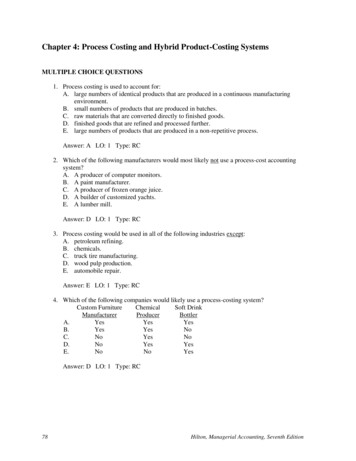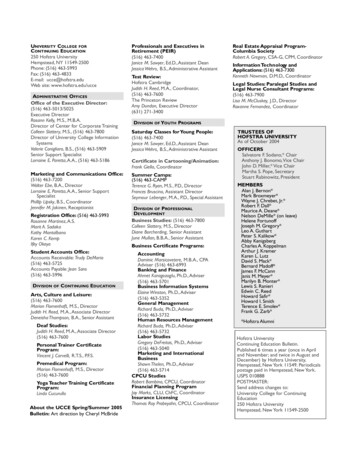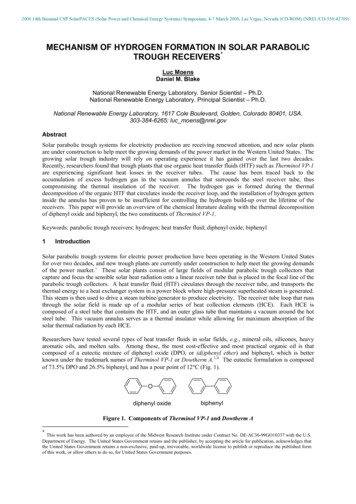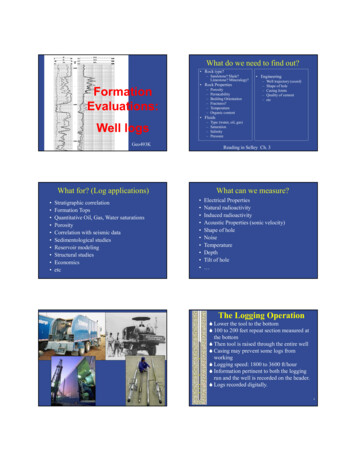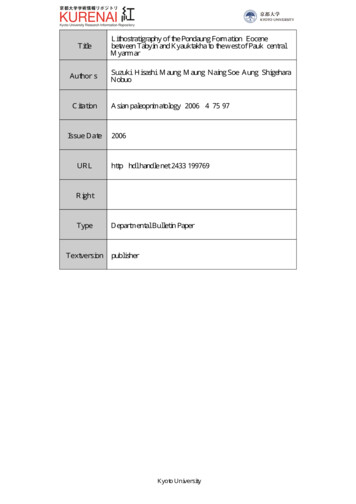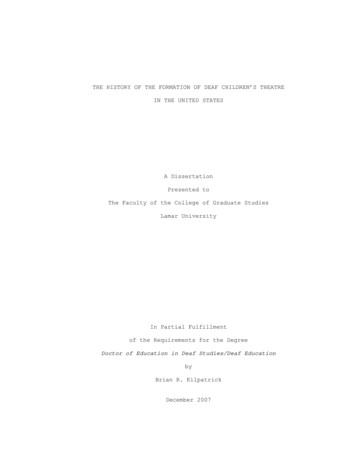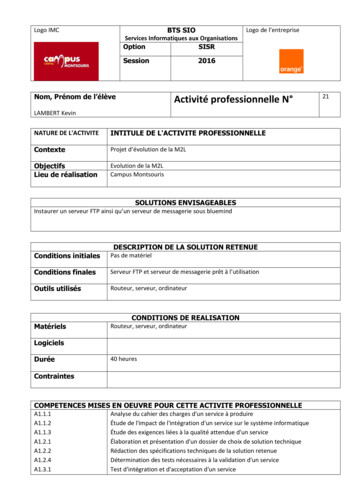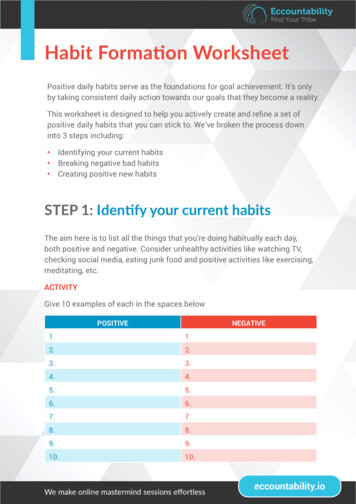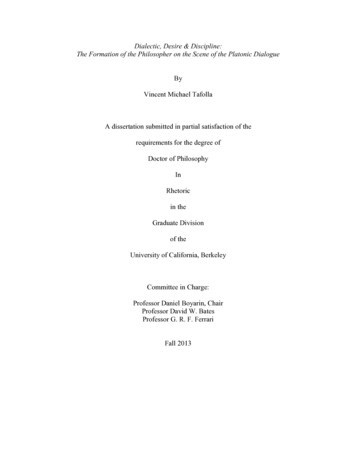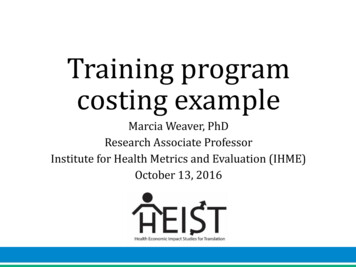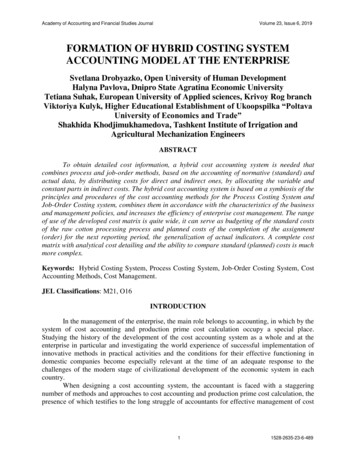
Transcription
Academy of Accounting and Financial Studies JournalVolume 23, Issue 6, 2019FORMATION OF HYBRID COSTING SYSTEMACCOUNTING MODEL AT THE ENTERPRISESvetlana Drobyazko, Open University of Human DevelopmentHalyna Pavlova, Dnipro State Agratina Economic UniversityTetiana Suhak, European University of Applied sciences, Krivoy Rog branchViktoriya Kulyk, Higher Educational Establishment of Ukoopspilka “PoltavaUniversity of Economics and Trade”Shakhida Khodjimukhamedova, Tashkent Institute of Irrigation andAgricultural Mechanization EngineersABSTRACTTo obtain detailed cost information, a hybrid cost accounting system is needed thatcombines process and job-order methods, based on the accounting of normative (standard) andactual data, by distributing costs for direct and indirect ones, by allocating the variable andconstant parts in indirect costs. The hybrid cost accounting system is based on a symbiosis of theprinciples and procedures of the cost accounting methods for the Process Costing System andJob-Order Costing system, combines them in accordance with the characteristics of the businessand management policies, and increases the efficiency of enterprise cost management. The rangeof use of the developed cost matrix is quite wide, it can serve as budgeting of the standard costsof the raw cotton processing process and planned costs of the completion of the assignment(order) for the next reporting period, the generalization of actual indicators. A complete costmatrix with analytical cost detailing and the ability to compare standard (planned) costs is muchmore complex.Keywords: Hybrid Costing System, Process Costing System, Job-Order Costing System, CostAccounting Methods, Cost Management.JEL Classifications: M21, O16INTRODUCTIONIn the management of the enterprise, the main role belongs to accounting, in which by thesystem of cost accounting and production prime cost calculation occupy a special place.Studying the history of the development of the cost accounting system as a whole and at theenterprise in particular and investigating the world experience of successful implementation ofinnovative methods in practical activities and the conditions for their effective functioning indomestic companies become especially relevant at the time of an adequate response to thechallenges of the modern stage of civilizational development of the economic system in eachcountry.When designing a cost accounting system, the accountant is faced with a staggeringnumber of methods and approaches to cost accounting and production prime cost calculation, thepresence of which testifies to the long struggle of accountants for effective management of cost11528-2635-23-6-489
Academy of Accounting and Financial Studies JournalVolume 23, Issue 6, 2019information management. In fact, there are few, many more cost accounting systems thatunderlie these methods, or combinations, of the basic costing and costing methods.When designing a cost accounting system, an accountant is faced with a staggeringamount of methods and approaches to cost accounting and production prime cost calculation, thepresence of which indicates a long struggle of accountants for the effective provision of costinformation management. In fact, there are few basic methods for cost accounting andproduction prime cost calculation, there are much more cost accounting systems based on thesemethods or their combinations.The scientific hypothesis of the study is the assertion that the evolutionary developmentof the cost accounting system occurs on the basis of heredity (the ability of the system to changeits state in certain time periods to create possible options for future development), naturalselection (the basis of competition and a tool for selecting the effective state of the system), andvariability ( the ability of the system to reproduce its characteristic signs and features in the chainof subsequent changes).REVIEW OF PREVIOUS STUDIESTraditionally, job-order, redistribution, and process methods are distinguished in thenational accounting school and practical activities. With that, the difference between theredistribution and process ones is not defined.A study of foreign accounting theory shows that American and European colleagues use“costing systems (calculation systems)” or “cost accumulation systems”, which act as analogs ofdomestic cost accounting methods. So, Dale & Plunkett (2017), depending on the “cost object,”distinguish two types of costing systems: job-costing system (work calculation system) andprocess-costing system (process calculation system).In the job-order method, accounting for the movement of production costs, that is, costaccounting in the remains of production in progress at the beginning and end of the period,accounting for increases and decreases in costs of production in progress for the period arecarried out for each order in the context of calculation items (Larson & Gray, 2017; Garbowskiet al., 2019).When applying the process method, accounting for the movement of production costs(that is, cost accounting in the remains of production in progress at the beginning and end of theperiod, accounting for increases and decreases in costs of production in progress for the period)are carried out for the processes in the context of the product type. If production costs cannot befully attributed to a single order or process, a combination of job-order and process methods isused (Shingo, 2019).If the production process includes mass production and some individual elements, it isadvisable to use a hybrid costing system or hybrid cost accounting. This situation was describedby Drury, (2006) in case if it is impossible to classify cost accumulation systems in job costing orprocess costing. The cost of individual work (operations) is determined by the process method,and then the cost of the product types is determined by the job-order method. This costaccumulation system is called a batch/operating costing and is described as a “combination ofboth the job costing and process costing systems”.Studying the approaches of domestic and foreign scientists to the methodological featuresof two basic cost accounting models allowed identifying the main factors for their identification:21528-2635-23-6-489
Academy of Accounting and Financial Studies JournalVolume 23, Issue 6, 2019Product uniqueness. Cost accounting for the execution of the production assignment(order) is used for unique products, cost accounting for processes for standardized ones(Drobyazko et al., 2019; Nesterenko et al., 2019).Production cycle. Cost accounting for the execution of the assignment (order) is used forsmall production cycles, cost accounting for processes for large (completed) production cycles(Hilorme et al., 2019).The complexity of accounting and documentation. Cost accounting for the execution ofthe assignment (order) requires deeper detailing, especially for projects or special orders, so it ismuch more complicated, time-consuming and requires more time than executing cost accountingfor the processes of calculation items (Karaoglan & Karademir, 2017; Yelisyeyeva et al., 2019).It should be noted that two basic models were formed at the beginning of the twentiethcentury, while modern production processes have a complex structure and the use of job-order orprocess methods cannot provide an adequate reflection of costs. Modern companies may noteven realize that they are using a hybrid cost accounting system, they simply adapted theiraccounting system to the operational and technical requirements of their business process, whichis considered as a whole.It should be noted that the two basic models were formed in the early twentieth century,while modern production processes have a complex structure and the use of job-order or processmethods can not provide an adequate reflection of costs. Modern companies may not evenrealize that they are using a hybrid cost accounting system, they have simply adapted theiraccounting system to the operational and technical requirements of their business process, whichis considered as a whole.METHODOLOGYAccording to the goal, dialectic, evolutionary, historical, and systemic approaches havebeen used to study cost accounting methods; the abstract logical method for determining themost promising cost accounting methods for the enterprise in particular.RESULTS AND DISCUSSIONSTo develop the recommended cost accounting model, it is necessary to perform asimulation of the production process based on the design of the resource flow and cost data. Thenext step is to build the optimal cost accounting system for the prime cost calculation, andfinally, the feasibility of implementing this model in the real conditions of operation of theenterprise under study should be verified.The production simulation model is based on the decomposition of the businessproduction process into simple blocks to better understand the conversion of resources intofinished products for the Campus Cotton Club Trading House.The main activity of the company Campus Cotton Club Trading House is the wholesaleof pharmaceutical products, the production of pharmaceutical products under its own brand andfor other customers.From the point of view of cost accumulation, the production process is conditionallydivided into two main blocks: the processing of raw cotton and the manufacture of products inassortment from it. The processing stage includes the processing of cotton in large volumes. Thenext block includes work, which is unique to both customer orders and individual batches ofproducts manufactured under its own brand. It is for this type of production that a hybrid system31528-2635-23-6-489
Academy of Accounting and Financial Studies JournalVolume 23, Issue 6, 2019is the best option for a cost accounting system. The processing stage consists of severalsuccessive redistributions and processes a large amount of raw cotton. In such a situation, it isimpossible to track the costs incurred for each specific ton of cotton. Therefore, it is mostefficient to accumulate costs at the aggregate level for a large batch and then distribute them to 1ton of processed cotton. This approach is based on the assumption that cotton processing costsare not differentiated, so there is no need to track cost data at the production unit level. Theprocess cost accounting method accumulates costs during the reporting period and distributes tothe production volume at the end, thereby determining the average cost of a production unit.The costs of the process are divided into direct (material, labor) and indirect. Directmaterial costs are determined by the amount of raw cotton spent during the reporting period,estimated by the method of writing-off of the weighted average prime cost (periodic or constant).Other material costs and labor costs are accumulated during the entire production process,therefore they are taken into account in a different way than material costs. In this case, thestandard costing system is the best option. The standard costs are written off in full (othermaterial, for electricity, for labor) for all cotton that is released and processed during thereporting period. The costs in accordance with the availability factor are allocated for the volumeof cotton that has not gone through the full processing cycle (work in progress). The deviationbetween the actual and standard costs is written off for the cost of the processed fiber.The variable part of indirect costs is distributed similarly, based on the coefficient of theaverage level of completeness of the cotton processing. The full standard amount of indirectcosts is written off for cotton, which went through a full processing cycle for the reportingperiod. The deviation between the actual indirect costs in the variable part and the standard oneis written off for the cost of the processed cotton.The development of a standard calculation will require a study of prior experience inapplying regulatory cost accounting at the enterprise. The operations of each redistribution of theprocessing must be carefully measured and calculated. Engineering of production processesshould be carried out by a technologist under the supervision of the chief engineer. Theaccountant of the production unit calculates, by the standard-cost method, the cost of 1 ton offiber obtained as a result of the processing of raw materials as a joint production stage for severaltypes of products. Using standard calculation for the processing is also advisable because ofminor and unlikely changes in technology.The opposite situation is observed with the second production unit. In practice, thecalculation of the manufacture of products in the range is adapted to the specific requirements ofthe customer or market conditions for products under their own brand. Cost fluctuations arerelated to the performance of specialized specifications such as the degree of cleaning of cotton,the number of layers of cotton on hygienic sticks (tampons), the number of units in the package,and so on.For the second block of the production process, it is suggested to use the cost accountingsystem for the assignment (order), which is intended to accumulate costs in individual units orproduction batches (orders). More attention should be paid on the features of cost writing-off.First of all, direct material costs include the cost of processed cotton obtained from the firstproduction unit. The processed cotton is stored in the warehouse, the value of the released andused cotton is written off for the manufacture of a certain type of production, the remains ofunused cotton are returned to the warehouse, and the production cost is adjusted by the “red-inkentry” method.41528-2635-23-6-489
Academy of Accounting and Financial Studies JournalVolume 23, Issue 6, 2019Electricity costs cannot be calculated in advance, so the best option is to record the actualmachine-hours used with the subsequent calculation of the amount of costs included
constant parts in indirect costs. The hybrid cost accounting system is based on a symbiosis of the principles and procedures of the cost accounting methods for the Process Costing System and Job-Order Costing system, combines them in accordance with the characteristics of the business
